A list of antagonist characters found in Disney's Mickey Mouse Comic Universe.
Click here to return to the main list.
- Click here to go to the protagonist list.
- Click here to go to the friend list.
- Click here to go to the animal list.
- Click here to go to the fiend list.
- Click here to go to the otherworlder list.
- Click here to go to the subseries character list.
- Click here for more options.
Keep in mind that since the characters and series have been around for so long, whether a character displays certain traits or not in any given story largely depends on the artist, the writer, or the time period.
Main villains
Pete note
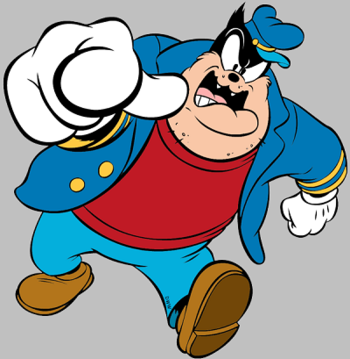
Mickey's Arch-Enemy for over 90 years of comic history. There's no question about it; It's Personal.
- Acrofatic: He's far more agile than one would expect from his size, even able to engage in Roof Hopping if pressed.
- Arch-Enemy: He is Mickey's most frequently recurring enemy and one of the few villains in the comic to also appear in animation.
- Big Bad Duumvirate: Sometimes forms this with other villains, most notably the Phantom Blot. In Alternate Universe stories, the Blot tends to be the true Big Bad and Pete is The Dragon.
- Bond Villain Stupidity: In the Gottfredson era, Pete always tried to directly off Mickey but was dissuaded to a more subtle approach by a partner-in-crime. When he became a villain that was likely to work alone, the trope kicked in for him. He regularly leaves Mickey in death traps that are very easy to escape or toys with him long enough for him to come up with a plan or for help to arrive.
- Bring Him to Me: With Mickey, generally. First time was in "Mickey Mouse Sails for Treasure Island", but that was a small scene and necessary. "The Mail Pilot" features a big scene for no other reason than Pete and Sylvester showing off. Whichever scientist or genius he needs to abduct for their knowledge also is at risk of being put through this. Bring her to me with Minnie, which is mostly in older stories. Any modern stories to pull it tend to acknowledge her as an adversary on par with Mickey.
- Cats Are Mean: He is a cat and is not a pleasant person at all.
- Character Check: Once in a while, Italian writers remember that the only reason Pete isn't much of a threat is that he usually gets caught by Mickey early, and when he doesn't he at least turns Mouseton's criminals in his personal gang, depending on how much time he gets without Mickey butting in. In the 2018 story "All of This Will Happen Tomorrow" he managed to keep Mickey off his back for three years, and when he was stopped he had just plunged the world into chaos and was literally seconds away from Taking Over The World, while the "Young Mickey" miniseries has his debut on Mouseton's crime scene consist in him, Trudy, and two others commit multiple series of robberies so successful that when he demanded the entire gold reserve of Calisota to stop the governor almost gave up.
- In the Ducktopia miniseries he had to pull an Enemy Mine, and eventually reformed. Comes the sequel Gambaville, where he builds and manages a wealthy suburb of Mouseton after striking rich honestly... And uses it to fill Gambaville with wanted criminals masked to the police through the use of Portis' new holographic technology to eventually take over the city while trying to ruin Mickey's relationship with his friends to keep him busy in case he started suspecting things. The only reason he's eventually found and caught is that he tried to recruit Miklos and, when the latter refused, made it appear he was pulling his usual shtick of committing crimes while appearing to be Mickey, resulting in Miklos, who had figured out the mysterious crime boss operated from Gambaville, deciding to join forces with Mickey, a move nobody could have possibly expected due everything that had gone through between them.
- Les Collaborateurs: Whereas the wartime cartoons of the period showed Pete, for all of his gruffness and brutishness, on the side of the Allies as Donald Duck's commanding officer, the 1943 comic story "On a Secret Mission" showed Pete working with the Nazi agent Von Weasel to try and steal the Americans' new long-range combat plane known as "The Bat" for Nazi Germany. His reward in case of success is stated to be 5000 bucks.
- The Corrupter: As per "Mickey Mouse Sails for Treasure Island" and "The Mail Pilot", do not let Pete and Sylvester on a boat unless you want the crew to turn against the captain.
- Cut Lex Luthor a Check: It's shown he could make a fortune by hiring himself to a private police agency or anyone who operates in the private sector to stop crimes. He doesn't do that because he likes stealing.
- Depending on the Writer: He has been depicted as anything from criminal mastermind with his own gang to a thug who wouldn't be able to design a way out of a cardboard box depending on what the story requires. His level of ruthlessness also varies between an Affably Evil everyman with no intention to inflict permanent harm, to a cold-blooded murderer who could casually eliminate his own friends and allies.
- Did You Actually Believe...?: Gottfredson-Walsh kept it so that Mickey never quite believed any nice stories told by Pete, such as in "Peg-leg Pete Reforms", and this remains how these things tend to play out, but the trope has occasionally come up in comics like "History Re-Petes Itself" and "Gentleman Pete!" whether it was Mickey being fooled or another character.
- The Dragon: When he is not the main villain of the story, he is usually the main henchman.
- The Dreaded: Most criminals in Mouseton are terrified of his wrath. Those who aren't will try and doublecross him... And find out that Pete will beat them bloody and rob them blind or get them arrested trying, and doesn't care if he's arrested in the process as long as he takes them down with him. Even Phantom Blot knows better than doublecrossing Pete, and if he has to work with him he'll give him a good deal and keep his word.
- Entitled Bastard: When he is not making demands, Mickey's helping him on his own initiative anyway.
- Even Evil Has Loved Ones: Pete has plenty of them, friends and family. Just read the "Allies of Pete" section for the most prominent ones. A moment of note occurs in "Mickey Mouse on Quandomai Island" when Pete puts his distrust and fears aside to save Trudy.
- Even Evil Has Standards: In an episode of House of Mouse, Mortimer tries to use the Mistletoe trick on Minnie. Pete kisses him himself so Minnie won't have to.
- The Family That Slays Together: Kickstarted by Carl Fallberg and Paul Murry, although they did not care about being consistent. In "Double Trouble", Pete is given a twin brother named Zeke, while in "The River Pirates" a twin brother named L'il Pete is introduced alongside the men's mother and gang leader, identified only as Maw Pete. However, "Mickey's Strange Mission" has an unspecified relative of Pete, Blackstone P. Percival, claim that Pete is the Black Sheep of the family. In addition to the characters listed below under Pete's family, various writers have introduced Pedro, Pete's brother, in "Enfim... Argh... Juntos!", Petula, Pete's protective Cool Big Sis, in "Fattening Fudge", (Black) Petra, a cousin in "Terror Of The Territory", Pit, a nephew and would-be future tyrant of Mouseton, in "Topolino e lo strappo cronospaziale", Alfonso "Al" Gambone, a Sicilian cousin of Pete, and his mother Assunta Bonfiglio in "Babbo Ciccione", Pierette and Jo, a Parisian aunt and uncle, in "Minni e la zia di Gambadilegno", Maude, an aunt that's doing jailtime for counterfeiting goldfish, in "Gentleman Pete!", and Crowbar, an uncle in "Topolino e la maxi-minicoppa". The animated works also chip in, such as the Mickey Mouse Works short "Mickey's Cabin", which gives Pete a criminal Country Cousin named Zeke. In regards to pets, two shorts feature Muncey, a dog owned by Pete who aids him in his schemes.
- Fat Bastard: He's overweight and not a nice guy. Overlaps with Large and in Charge when he is the one who commands his own minions.
- Faux Affably Evil: Depending on the Writer; he can be genuinely Affably Evil, but more often he's pretending.
- Funetik Aksent: He speaks in a typical "tough-guy" tone.
- Friendly Enemy: To an extent, anyways. It's not like he has any problems with smacking Mickey around when the opportunity arises. The feeling's mutual. As per "Mickey Mouse Joins the Foreign Legion" and "History Re-Petes Itself":Pete: "I'm sure glad I hate yuh! Cause if I didn't hate yuh, I'd like yuh! An' I don't wanna like yuh — I hate yuh too much!"Pete: "I hafta hate him, 'cause if I didn't, I might like him! #%&*! An' I don't wanna like him!"
- Genius Bruiser: He is violent, but is clever enough to find the use of any new technology or make a cunning plan. On a good day, he's able to go toe-to-toe with the Phantom Blot.
- Gone Horribly Wrong: One story had a therapist decide Pete lacked stories of good triumphing over evil in his formative years and assigned fairy tales to be read to him by a prison guard before sleep. This apparently traumatized Pete so hard that once he was allowed parole, he started kidnapping professional storytellers and children writers and force them to tell him fairy tales where bad guys win.
- Handicapped Badass: It's why he was called "Peg-leg Pete" for a time. The artists could never remember just which leg was supposed to be the peg-leg, though, so in the end they gave him two normal legs. Floyd Gottfredson dealt with this by having Pete explain in "The Mystery at Hidden River" that he'd gotten a prosthetic upgrade. "The Mystery of Tapiocus VI" by Romano Scarpa reiterated this by having Pete's covering prosthetic get damaged so only his pegleg remained visible. If one must know, in his first appearance in the animated short Alice Solves the Puzzle as "Bootleg Pete", his peg-leg is his right leg and through all the switching-around this can be assumed to be the "true" version.
- Happily Married: It varies whether Trudy is portrayed as his wife or his live-in girlfriend, but their relationship is a happy one.
- Henpecked Husband: Occasionally. One story(title?) had Trudy forcing Pete and his friends to shape up, even threatening them with a Rolling Pin of Doom. They complied.
- Identical Stranger: Duke Feline of Mazumia in "The Mystery of Tapiocus VI" is alike enough that Pete could switch places with him easily.
- I Have Many Names: Bootleg Pete, Peg-leg Pete, Black Pete, Dirty Pete, and Big Bad Pete are a few. And then there's the many fake identities he's used over the years.
- I Lied: Every single time he looks to have given up crime, like in "Island in the Sky", it's a ruse.
- Jerk Justifications: In the form of It's What I Do.
- Just Between You and Me: Pete's prone to do this because of his long standing enmity with Mickey. In "The Mystery of Tapiocus VI", it causes his partner-in-crime to turn on him and save Mickey. In "History Re-Petes Itself", it causes Mickey to use Pete's plan against him (somewhat by accident).
- Kick the Dog: His treatment of Hickup in "The Captive Castaways" serves no purpose but to show off his cruelty. Recurring partner-in-crime Dexter Dingus also gets dealt a detrimental amount of violence and disdain, although this at least is used to further the story.
- Kick Them While They Are Down: How about Pete and Sylvester tricking Mickey into eating non-food while eating a rich dinner in front of him themselves when he's in their power and set for execution within an hour in "The Mail Pilot"? Or Pete having Mickey bound and planning to kill him taking a few extra minutes to shove his face into a copy machine to make a few pictures in "The Copy-Cat Crimes"?
- King of Thieves: When given enough time to set himself up, Pete will usually take over crime in Duckburg and reorganize it in his own gang. In one occasion he managed to do from jail, with Trudy working as his substitute.
- Master of Disguise: Readers can usually pick him out, but the protagonists rarely can.
- Never Learned to Read: A trait during the Gottfredson-Walsh era. Pete can't read according to "The Captive Castaways" and still can't in "On a Secret Mission". Modern comics have done away with it.
- The Nicknamer: The Phantom Blot is "Blotty", Dexter Dingus is "Dexie", Prince Penguin is "Penny", Eurasia is "Lady Longtail", etc.
- Not-So-Harmless Villain: Italian stories usually depict him as not really dangerous... But also tend to point out that it's only because Mickey usually stops him before he can steal some funds for a larger plan, and have shown that with Mickey out of the picture for as little as a week he can become as bad as a threat as the Phantom Blot and often taking over all crime in Mouseton. A story even openly declared him #2 public enemy, below Phantom Blot but above doctor Vulter (who in the same story was explicitely identified as a terrorist).
- Obfuscating Stupidity: At times, like in "The Ghost Town Airport", he uses this to become a Devil in Plain Sight.
- Only One Name: Whether his name comes with an adjective or not, Pete is Pete. His family is often named as if "Pete" is a surname, but it's not a clearcut case. In Goof Troop, his full name is given as "Peter Pete", but he's only ever referred to as "Pete" (or "Petey"). In "Mickey's Strange Mission", his full name is given as "Percy P. Percival" and it's made clear that he finds the name embarrassing.
- Outlaw: There are several stories with a Wild West setting in which Pete gets this role. "The Bar None Ranch", "Double Trouble", "The River Pirates", and "Two Gun Sheriff" are all examples.
- Punch-Clock Villain: To varying degrees but not uncommon for him to treat crime as a regular job up to the point in one story Vicky hires Mickey to prove Pete's innocence of the crime he was arrested for because it happened on their vacations and Pete would never "work on vacations".
- Revenge: After 90 years, yeah, sometimes all he hopes to get out of a scheme is revenge on Mickey.
- Rogues' Gallery Transplant: Not only was Pete already around to pester Mickey's predecessors Oswald and Julius, but he's also been a recurring pain in the lives of the Ducks. He even has a set of henchmen, Red Eye and another guy, exclusive to his confrontations with the feathered protagonists.
- Rooting for the Empire: In-Universe, in one story he claims to, while reading, always take a side of monsters, hags and werewolves.
- Trademark Favorite Food: Licorice and orange candy according to "While We Were Waiting".
- So Long, Suckers!: Happens offscreen in "Race for Riches".
- Stout Strength: He's fat and large, but has strong muscles under his blubber, enough to be far more agile than one would expect and beat up most opponents.
- Suspiciously Similar Substitute: There's been a number of Pete lookalikes during the Western Publishing era that would be Pete for all but the name used. There's Phil the Pill Pusher in "The Mysterious Pill Plot", Fingers Fagin in "Minnie Mouse" (1952), and Daddy Doomie in "Super Goof vs. Daddy Doomie and Dr. Malstrom". Dan the Dogcatcher seems to have been meant to be Pete at first, but then was treated as a separate character most likely for continuity reasons.
- Unholy Matrimony: The Italian artist introduced the character Trudy van Tubb, who serves as Pete's romantic partner and partner in crime at the same time. The two are shown as a happy couple in Italian stories till today.
- Ungrateful Bastard: Sometimes Mickey rescues him from death only to be put into an even worse predicament by Pete himself. Or as per "Topolino e i misteri del monte Acchiappanuvole", saves him back but robs him when he's unconscious.
- Villain Decay: A strong case of Depending on the Writer and unavoidable given how long he's been in business. In present day, Italian writers often turn him into a Harmless Villain due to the family man context created in several focus comics, while the rest of Europe generally keeps him a threat.
- Villain Protagonist: Nowadays stars in his own stories, mostly Italian ones. They either deal with his everyday life and family, with his everyday life in prison, or with his interactions with other villains.
- Villainous Crush: Some older comics have him being heavingly attracted to Minnie Mouse, sometimes trying to force her into a relationship with him. In more recent comics the crush is gone as Pete is usually portrayed as being in a loving, happy relationship with Trudy.
The Phantom Blot

A master criminal who dresses in a black sheet. He's more dangerous than one might initially be led to believe. He's Mickey's other Arch-Enemy.
- Adaptational Abomination: It's not uncommon for adaptations to turn him from a guy in a suit to a straight up Living Shadow or ink. Wizards of Mickey, notably, has him start out as a normal wizard (well, normal for the setting, at least) not even wearing the costume. It's not until after his defeat and subsequent banishment to the shadow realm that he gets the iconic appearance, albeit with added Spikes of Villainy.
- Arch-Enemy: In the comics, he is established as Mickey's most dangerous foe. Less so in animation, where he's only appeared as a Monster of the Week in an episode of DuckTales (1987), appeared in one episode of Mickey Mouse Works, two shorts and one episode of House of Mouse, and one of the 2013 Mickey Mouse shorts.
- Bad Guy Bar: Might own one, the Rorschach Club, according to the Mickey Mouse Works short "Mickey Foils the Phantom Blot".
- Big Bad Duumvirate: He sometimes teams up with Mr. X or with Pete to form this. In the regular continuity, the Phantom Blot and Pete tend to treat each other as equals and sometimes rivals, while in Alternate Universe stories (such as the Wizards of Mickey series), the Blot is more often depicted as the Big Bad with Pete as his Dragon.
- Biting-the-Hand Humor: Under the mask, he resembles Walt Disney himself.
- Bond Villain Stupidity: A rare justified example. In his original apparence, Mickey asks why he didn't just kill him when he had the chance. The Blot reveals that he's too soft-hearted to watch people die.
- Bunny-Ears Lawyer: Sure, look at his debut appearance at a glance and all he did was steal cameras, but the fact that he was so good at it is what makes him so dangerous in the eyes of the police. What could they possibly do if he suddenly decided to go after something more valuable? He actually was going after something more valuable that they didn't know about; it was hidden in one of the cameras.
- Calling Card: An ink blot on a white piece of paper was a common way to get his messages across, but modern comics rarely retain the trait.
- Cardboard Prison: Even if the heroes manage to arrest him, the Blot manages to escape by inventing some gizmo from the electronics available in jail. At one point, he escaped by turning himself into electricity.
- Card-Carrying Villain: The most exaggerated version of the character wants to be seen as evil incarnate and would hate for anyone to think otherwise.
- Clothes Make the Superman: Sometimes:
- In "The Blot's Double Mystery", the Phantom Blot wears a cloak that's black on the outside so he's hard to see in the dark, white inside-out so he can use the other side when he needs to hide in a snow landscape, and capable of reflecting infrared when in warm places so that the Blot turns invisible.
- In the Darkenblot series he has the titular Darkenblot, a formidable suit of Powered Armor, of which there have been five iterations:
- The prototype was assembled from a number of devices the Blot had tricked the prison's director to let him build, allowing to break out with ease once he can put them in the same place and have a lightning hit them. Also serves to hint at the real nature of the Darkenblot, as in the first story it was first shown to be an army of robots and then nothing but a bluff.
- The original Darkenblot easily thrashed Robopolis' police robots and could fly-but wasn't resistant enough to survive a Turbine Blender, getting wrecked when Mickey tricks PB into flying into one.
- The Darkenblot 2.0 is the original repaired and improved with heavier armor and more weapons, and inflicts a mighty Curb-Stomp Battle on an army of crazed robots. It gets destroyed when Phantom Blot activates its self-destruction to destroy the device that had made Robopolis' robots go insane, as by the time he reached it he was out of ammo.
- The Darkenblot 2.1 seems identical to the 2.0, making Mickey suspect a copycat until he notices a large yellow button: it's a powerful EMP device that, alongside a second 2.1, allows Phantom Blot to pull a massive scam to fund his newest plot and build the 3.0.
- The Darkenblot 3.0 has even more armor and improved strength than before and, as a response to the circumstances that got the 2.0 destroyed, has switched to energy weapons, but is now too heavy to fly. The improvements are so great that, when confronted with four power armors designed to thrash the 2.0 and what Robopolis expected the 3.0 to be able to do, Phantom Blot wins in a minute without bothering to fire his guns.
- Curse of The Ancients: He seems to enjoy using "Curses!" or using "thousand" to describe things - and mentioning Caesar, if his debut story is anything to go by.Phantom Blot: "Curses! Ten thousand curses!" / "Caesar's ghost!" / "Curse the luck!" / "Thousand names of a devil!" / "Great Caesar!"
- Dark Is Evil: The black wearing, ghost-like (and sometimes themed) master criminal that hides in the dark is evil. Who saw it coming?
- Death Trap: He loves these, and he's actually got a reason to use them because he can't bear to watch people die. He's damn good at making them too, more often than not sitting comfortably in Rube Goldberg Hates Your Guts terrain. Mickey survives them more out of luck than any particular skill.
- Depending on the Writer:
- Look-wise, the main tradition is to have the Phantom Blot in costume and avoid showing his face. Italian stories, on the other hand, regularly ditch the idea of his appearance being a costume.
- Personality-wise, his position in the Sliding Scale of Villain Threat and the Sliding Scale of Villain Effectiveness can vary widely. From a Paper Tiger to the Evil Overlord, and from a Personal Threat (to the heroes) to a Global Threat with Take Over the World as his final goal.
- Also largely depends on the type of story. Silvia Ziche (1951-) is a prominent Disney comics writer, whose style involves over-the-top parodies of more conventional Disney stories. One of her 1990s stories, features the Blot's latest scheme at world conquest defeated with the easiest way possible. The Blot's plan required so much effort on his part, that he did not even have enough time to sleep. After more than a few days of sleep deprivation, the Blot collapses and is in no condition to complete the master plan.
- Diabolical Mastermind: Although a fine combatant, he favors the use of his intellect backed up by stealth to accomplish his goals.
- Dogface: Unlike most dogfaces, the Blot has no muzzle at all and a curiously flat nose, almost like a koala's.
- The Dreaded: He normally loves being feared, and actually banks on his Villain Cred for his heists. To the point that when he stopped being feared he temporarily wiped out the memory of everyone in Mouseton to "correct" the situation (he succeeded and escaped arrest).
- Even Evil Has Loved Ones:
- "The Big Fall" reveals that he has a very young daughter, the Phantom Brat. After being captured, he is given permission to say goodbye to her by explaining his arrest through a bedtime story where he is a benevolent king and Mickey is a cruel villain who imprisoned him. He urges his daughter to dream of happy endings while he is away.
- "The Phantom Blot Meets the Mysterious Mr. X" establishes the Phantom Blot and Mr. X as solid friends. They respect each other's intellect and like cooperating on crime.
- In "A Mancha Cor-de-Rosa", the Phantom Blot meets the Pink Blot, a female version of him that helps him out on several occasions in ways that might be just a tad unexplainable. The Phantom Blot does not pick up on this. When she reveals her face, she also turns out to be quite the looker and she and Phantom Blot arrange to marry. Shortly before the marriage, it becomes clear that the Pink Blot is a shapeshifted Mad Madam Mim, his periodic Abhorrent Admirer, and that's the end of that romance.
- Evil Genius: He is one of the most intelligent of Mickey's enemies.
- The Faceless: Averted or played straight, as explained under Depending on the Writer.
- The Fagin: To Alberta in "The Return of Phantom Bob".
- Flanderization: Whereas the original was limited by his soft-heartedness, some authors have taken him to the logical extreme by making him The Sociopath, while others have gone for the illogical extreme by making him a cartoonishly evil Card-Carrying Villain. Of course, there are also writers that do the original justice.
- Impossible Thief: He generally cheats by using technology that allows him to do what's not normally possible, like when he turned himself two-dimensional in "Blotting Out the Blot". Some tricks have been more clever, like when he made the paint on some paintings invisible by spraying in stuff through the museum air vents, making it only look like they'd been impossibly stolen, and then bought the "empty canvases".(title?)
- Knight of Cerebus: Comics featuring the Phantom Blot tend to be a lot darker than most other stories.
- Large Ham: In his animated incarnations and some Western Publishing stories, he is rather over-the-top.
- The Man Behind the Man: Occasionally, he turns out to be the real mastermind after someone else is thought to be the one behind the latest crime. One example would be the Darkwing Duck ''Campaign Carnage'' arc, where the ending revealed that he was the one who gave Constance A. Dention the magic ink that she used to become Suff-Rage.
- Manipulative Bastard: Lets look at "The Blot's Double Mystery" and how the Blot hypnotized Mickey into stealing a worthless hat as both a test and as a diversion. His true goal was nothing material or even Mickey's death, but to get Mickey locked away for attempted murder on O'Hara as a way to hurt the both of them. He'd later use the hat in a plot to get O'Hara arrested too. Another story (title?) has him threaten Goofy so he can blackmail Mickey into presenting evidence that the Blot will be at a certain place at a certain time to the police, to throw them off his tracks. Mickey stops the threat and is able to reveal the truth to the police, who are now certain the Blot will not be at that time in that place. Which is exactly what he wanted!
- Master of Disguise: Several stories, like "Perils of Mickey" and "A Phantom Blot Bedtime Story", have him utilize fake identities. Oftentimes, his disguise consists of Latex Perfection masks on top of his hood. Used to good effect in some stories. One story has Mickey interact with several different men during a mission, from stage performers to street beggars. He learns at a later point that everyone of these guys was the Blot in disguise, as part of a scheme of vengeance. Another story has Mickey breaking and entering a suspect's house, while his ally for the story serves as his lookout. He finds an entire gang waiting for him inside, turns to his ally for help, ... and finds out that his ally was just another identity of the Blot.
- Master Forger: Being a master criminal, he has often been portrayed as an expert forger. Usually if his plan involves stealing paintings, he will have personally painted identical forgeries to swap them for. He's also been the mastermind behind several money counterfeiting scams.
- No Name Given: We probably don't know his real name. Some Italian stories have
 The Un-Twist that he's actually called Mr Blot, Phantom. However, not every fan agrees. The Goofy Reporter series shows him before he became the Blot and reveals his name to be Basil Blackspot. However, this story might be an Alternate Continuity and have no bearing on the regular canon. The Phantom Blot has also shown an affinity for the name Bob as shown in the Darkwing Duck ''Campaign Carnage'' arc and "The Return of Phantom Bob", but "Bob" might as easily be based on "Blot" as "Blot" on "Bob". Averted in some German translations, where the name of the "unmasked" Blot is "Plattnase", often leading to Dub-Induced Plotline Change. Sometimes, Plattnase is treated as a seperate character who is merely impersonating the Blot.
The Un-Twist that he's actually called Mr Blot, Phantom. However, not every fan agrees. The Goofy Reporter series shows him before he became the Blot and reveals his name to be Basil Blackspot. However, this story might be an Alternate Continuity and have no bearing on the regular canon. The Phantom Blot has also shown an affinity for the name Bob as shown in the Darkwing Duck ''Campaign Carnage'' arc and "The Return of Phantom Bob", but "Bob" might as easily be based on "Blot" as "Blot" on "Bob". Averted in some German translations, where the name of the "unmasked" Blot is "Plattnase", often leading to Dub-Induced Plotline Change. Sometimes, Plattnase is treated as a seperate character who is merely impersonating the Blot. - Odd Friendship: With Melinda, Mickey's favorite aunt. He had become her temporary neighbour while preparing a heist, presenting himself as a crime novelist with some odd habits and having no idea who his friendly neighbour or her favorite nephew are... And ran like hell in the belief he had been tracked down when Mickey visited his favorite aunt.
- Phantom Thief: Was his name, by chance, a giveaway?
- Pragmatic Villain: At his worst, the Phantom Blot wants to Take Over the World... So he can be found on the front lines to deal with world-ending threats, even risking his life and saving his enemies for that.
- Retcon: Some authors ignore the fact that the Blot was captured and unmasked at the end of his first story and imply that Mickey has never seen his true face or seen him brought to justice.
- Rogues' Gallery Transplant: He appeared as a Monster of the Week in the DuckTales (1987) episode "All Ducks on Deck" and also fought Darkwing Duck during the final two story arcs of his comic book.
- A number of 1960s stories used the Blot as a new opponent for Uncle Scrooge, though most of them were rather weak in characterization. They were intended to introduce the Blot to a wider audience, but the characters seemed mismatched.
- Sesquipedalian Loquaciousness: He tends to have a large vocabulary.
- Surrounded by Idiots: Mostly a Western Publishing trait as it is mostly those stories he has non-character henchmen in.
- Terms of Endangerment: The Phantom Blot is an expert at this. He even managed to make genuinely thanking Mickey for allowing him to say goodbye to his daughter sound menacing in "A Phantom Blot Bedtime Story":Phantom Blot: "Sure I do, Mouse, and I always pay my debts! And I can't wait to pay you back!"
- Took a Level in Badass: In some stories he becomes an enormous danger even in combat and not just for his brains, most notably Ultraheroes, where he has been given a device that allow him to turn himself liquid.
- Done repeatedly in the Darkenblot saga. The saga is named after PB's Power Armor... That he improves and modifies in every story: the first model could easily thrash any of Robopolis' police robots, even the combat-oriented Panthers, and could fly extremely fast, but was crippled when Mickey got it in a large moving turbine; the 2.0, obtained by improving the first, is tougher and better armed, and turned the Phantom Blot into a One-Man Army; the 2.1 seems identical to the 2.0, to the point Mickey was immediately suspicious because of it, and then noticed the one modification, a large button on the chest that generates a powerful EMP pulse that, coupled with well-placed crates and an identical copy, allowed him to fake having a teleportation device for a scam that netted him two billion dollars; and the 3.0 could casually smash four powered armor designed to take on the previous model without using the on-board weapons (that had been upgraded to Energy Weapons from the ballistics used with the original and the 2.0), but at the price of becoming too large to fly.
- Top-Heavy Guy: He is occasionally drawn with a large chest and skinny legs, most notably in his appearances on Mickey Mouse Works and House of Mouse.
- Villain: Exit, Stage Left: One of the villains who does this most. Some stories go as far as to imply that he has ''never'' been captured properly. On occassion, stories depict him in a cell, only to imply that it will take him a few minutes or hours to escape. Other stories give him improbable escapes. A Danish story has the Blot falling from a mountain during a battle with Mickey. Mickey mourns his death, flies a private plane alone, and returns home without interacting with anyone. Yet finds a message from the Blot in his office, realizes that someone stole a decorative feather from his hat ... while he was wearing it, and he seems to hear the Blot's voice outside his home. The story ends there, with a disturbed Mickey.
- You Have No Chance to Survive: He frequently gloats about how unlikely it is for Mickey to escape his death traps.
Emil Eagle
First appearance (in this 'Verse): "The Case of the Dazzling Hoo-Doo", 1968An evil inventor whose origins lie in the Disney Ducks Comic Universe as a rival of Gyro Gearloose. He became a regular opponent of Mickey Mouse two years later and a core foe of Super Goof, who debuted another two years later. An example of a shared Modular Franchise villain at its finest!
For a comprehensive list of tropes applying to Emil Eagle, see his entry on the Disney Mouse And Duck Comics character page.
Pete's family
Zeke
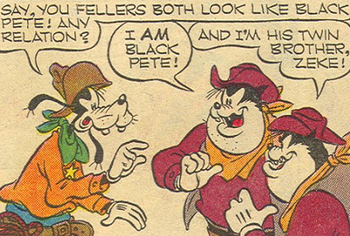
Pete's twin brother.
- Always Identical Twins: Zeke and Pete are this. An argument can be made for Always Identical Triplets if Li'l Pete from "The River Pirates" is counted, as the two stories do not preclude the other twin's existence.
- Expy: Like they often did, Fallberg-Murry recycled concepts from this story for another. Specifically, another identical twin of Pete shows up in "The River Pirates". The difference between Zeke and Li'l Pete is, well, that Li'l Pete didn't do much growing.
- Twin Switch: With "Scooby-Doo" Hoax elements. Pete and Zeke both pretended to be Pete, who held the most notority between the two, to confuse the townfolk into thinking there was nothing they could do against a dangerous crook that was everywhere at once.
Trudy Van Tubb

Pete's girlfriend and partner-in-crime; some stories even depicted her as his common-law wife. She has a sister named Becky.
- Acrofatic: She's a poor choice of opponent to pick a fight with.
- Battle Couple: She and Pete have about the same physical capacity and aggression level. When with Pete, though, Trudy tends to be a little less hard-boiled than when she is alone.
- Breakout Character: Easily the most popular of Romano Scarpa's characters on the Mickey Mouse side of things. She fills a niche in her ability to expand on Pete. Coincidentally, she also is the second or third most high-profile female villain in the joint-Mouse/Duck universe, being upstaged only by Magica De Spell and arguably by Ma Beagle.
- Cordon Bleugh Chef: Occasionally depicted as this. She has some really weird recipes that she's very proud of but almost nobody likes. Luckily, Pete is one of the few people who does like her cooking; he does admit that her her jam tarts with custard and anchovies might not be for everyone, but he genuinely enjoys them.
- Distaff Counterpart: Same species, same built, and same capabilities and strategies as Pete.
- The Dragon: Whenever Pete manages to assemble a large gang, Trudy serves as his second-in-command. In "The Chirikawa Necklace" she was even leading it while Pete was in jail, relaying his orders and dealing with the day-to-day operations.
- Obnoxious In-Laws: Pete views Becky as such, going so far as to try to get arrested to avoid her in "Gambadilegno e la nottata "no"".
- Outlaw Couple: Well, they are a criminal Battle Couple.
- Punny Name: "Van Tubb" is a fat joke. The English version of "Goofy Adventures Online: Crimes of Passion" somewhat comes back on this by having Pete own a boat cutely named "Trudy's Tub".
- Unholy Matrimony: Trudy and Pete enjoy a solid and even happy relationship.
- The Vamp: Averted. She's occasionally tried to be one of these, but isn't pretty or sexy enough to pull it off.
- Victorious Childhood Friend: She started out as a childhood acquaintance of Pete. Later on, she became his girlfriend, and later still was depicted as living together with him. Some stories even refer to her as his wife.
- Woman Scorned: Lets just say that Trudy doesn't take kindly to Pete wanting Minnie as his queen in "Topolino nel favoloso regno di Shan-Grillà". Mickey wouldn't have defeated Pete without her wrath.
- Wrong Genre Savvy: In one story she becomes enamored with action movies and tries to force Pete and his gang to act more like characters in them. It forces Pete to form an alliance with Chief O'Hara, who had exact same problem with the city Mayor, to stage a scenario showing both her and the Mayor how terrifying the action-filled life actually is.
Maw Pete

Pete's mother. Depictions of her vary, but she's usually an ambitious criminal.
- Ascended Extra: Maw Pete's first mention occurs in 1942's "Donald Duck Finds Pirate Gold", 26 years before she'd have a starring role. Pete requests his crew that if anything happens to him, his remains are sent to his "old mudder in Pittsboig". Which Pittsburg(h) he refers to isn't specified.
- Depending on the Artist: Counting animation, Maw Pete has made her appearance four times and none of those times resembled another. The image used is of her debut comic, "The River Pirates", in which she is the leader of a gang Pete belongs to. It is the only time she is depicted with glasses. In "The Spirit Of Christmas", her one other comic appearance, she's only shown during Pete's childhood years and unlike the 1968 version is thin, blonde, and law-abiding. In Mickey, Donald, Goofy: The Three Musketeers, only a close-up portrait of her exists, which shows her as large again, but with red hair this time. As she's drawn in Institutional Apparel, it follows she's a convicted criminal. The Mickey Mouse Clubhouse version from the episode "Mickey's Pirate Adventure" is also large, but with grey hair. Whether she's a crook or not is not elaborated on.
- Evil Matriarch: Maw Pete is usually established as a criminal. Counting all comics, she'd be the mother of six children: Pete, L'il Pete from "The River Pirates", Zeke from "Double Trouble", Pedro from "Enfim... Argh... Juntos!", Petula from "Fattening Fudge", and an unnamed woman from "Topolino e il problema di Natale". Only the last one is not a crook herself.
- Pirate Girl: In "The River Pirates", she's the leader of said river pirates and the only woman in the gang.
- Unnamed Parent: She's Pete's mother and only known as "maw". Even the henchmen that aren't her sons call her "maw".
Portis

Pete's genius cousin who occasionally works for him and sometimes for other villains like the Phantom Blot.
- Ascended Extra: Portis was created to give Pete access to fancy weaponry to expand the kind of stories he could star in. Portis was initially written as his lesser, but he's been increasingly written as an equal to Pete to the point they now qualify as an equal pair. He's even been the sole villain in a number of stories, usually ones focusing on some new invention or weapon he's testing out — most often with Mickey as the target.
- Bad People Abuse Animals: His debut comic and "The Transmutant Gifts" have him target and endanger animals.
- Cats Are Mean: Like everyone in Pete's family.
- The Family That Slays Together: See the entry in Pete's section and decide for yourself which of the (non-Italian) characters would be related to Portis too through all the Continuity Drift going on.
- Fat and Skinny: Portis is the skinny one, Pete the fat one.
- Mad Scientist: All his inventions are contributions to crime.
- Terrible Trio: In a few stories, he forms this with Pete and Trudy.
Chirpy Bird

Pete's girlfriend and partner-in-crime.
- Big Bad: She usually gets Pete to do the dirty work for her.
- Distaff Counterpart: Contextually averted. It is the norm in the Duck & Mouse comic universes for female partners to be the male characters with Tertiary Sexual Characteristics slapped onto them. Even Pete's usual girlfriend Trudy follows that norm. Chirpy is one of the rare ones with a design that is her own, although it still qualifies as bulky.
- Outlaw Couple: With Pete.
Pierino and Pieretto

Pete's mischievous nephews who admire their uncle. They are rivals of Morty and Ferdie.
- Cats Are Mean: As with pretty much all of Pete's family.
- The Dividual: As Disney siblings are wont to be, Pierino and Pieretto are narratively inseparable.
- The Family That Slays Together: See the entry in Pete's section and decide for yourself which of the (non-Italian) characters would be related to Pierino and Pieretto too through all the Continuity Drift going on.
- Parental Abandonment: Not quite as they explicitly only occasionally visit Pete, but their parents never make an appearance and no information is given about them either. Humorously, in their debut comic they were to stay with Pete for a while, but he couldn't take them in because he was in jail. So, Mickey took them in for a while.
- The Prankster: They are mean-spirited pranksters, although Morty and Ferdie prevent their worst.
Pete's allies
Sylvester Shyster
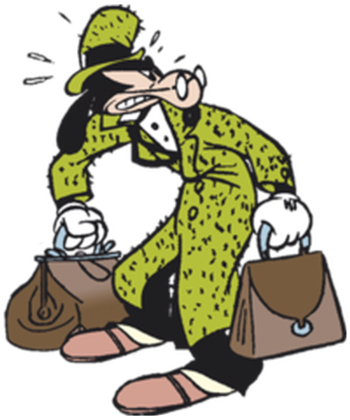
Shyster is Mickey's second oldest recurring villain and one of the few Disney comic-characters that were actually created by Walt Disney. Shyster is an evil lawyer who often works in cahoots with Pete.
- Amoral Attorney: He is a lawyer who does dishonest things.
- Brains and Brawn: He is the brains, Pete provides the brawn.
- The Bus Came Back: Three, arguably four, times! He made a comeback in 1942 after being absent since 1934, had a one-shot appearance during the 50s, became a regular in Italian stories starting the early 60s, and was fully restored as a regular when the rest of Europe picked him up in the late 90s.
- Cartoon Creature: It isn't certain what animal he is supposed to be.
- The Corrupter: As per "Mickey Mouse Sails for Treasure Island" and "The Mail Pilot", do not let Sylvester and Pete on a boat unless you want the crew to turn against the captain.
- Hanging Judge: Got to be this in "Vacation Brake". With some manipulation, Sylvester legally became the judge of Elk Pit and exclusively used his power to serve his own whim.Sylvester: "Oh no! Picknicking without a permit?! Why, according to new town ordinance number 142, article 18, paragraph 9, section C, that's punishable by imprisonment for no less — and no more — than exactly whatever I say!"
- No Honor Among Thieves: Leading to Honor Among Thieves. In their debut comic, "Death Valley", Sylvester and Pete have to follow Mickey into the desert. Sylvester reasons that Pete is not the most suited partner for that and so finds himself a local crook. Pete overhears Sylvester's plan to get rid of him and goes after Mickey alone. He finds him, but due to circumstances he ends up chained to him stuck in the desert with no water. Sylvester and the other crook come across the two, prompting Pete to rush to them asking his "old friend" for water. Sylvester gives him his bottle with no further questions and not even an objection to Pete's suggestion to split the loot three ways. They've been besties ever since. (The other crook turned out to be a deputy sheriff.)
- You Don't Look Like You: "The Thunderbolt Machine" is the only (non-remake) story featuring Shyster created during the 50s and he's completely unrecognizable. What probably happened is that they sought to modernize his design, but it ended up draining him of anything distinctive.
Eli Squinch

A miserly businessman who spends a lot of time penny-pinching and trying to make more money through shady (and sometimes downright illegal) businesses. Like Sylvester Shyster, he has on several occasions teamed up with Pete to attain some common goal.
- Abhorrent Admirer: Clarabelle Cow is his abhorrent admirer, although due to his own actions. In "Race for Riches", he pretends to be interested in her so he can get at the secret fortune of her grandfather. When that goes wrong, he buys up her debts at the bank so he can keep her house hostage if she doesn't cooperate. Since 2013, the setup of Eli Squinch still being the mortgage collector has been used as a motivation to fool Clarabelle again in such stories as "A Serenade from Squinch" and "Mortgage Misery". Both end with Squinch failing in his objective and having to sit out his time with Clarabelle so as not to draw suspicion.
- Bad People Abuse Animals: He's worked several horses to death to power his sawmill plant cheaply. His purchase of Bobo, a baby elephant, was to replace the horses. He didn't expect to be sent a youngling, noting it might not be able to meet the demands of the work either, but that wasn't stopping him from wanting to give it a try anyway.
- Brains and Brawn: He is the brains, Pete provides the brawn.
- The Bus Came Back: Squinch disappeared after the 30s, made a total of four appearances from the 40s to the 70s in the Italian comics, and then finally was fully brought back as a regular in the early 90s. In relation to his presence in the USA, his return comic is the 2005 publication of "The Treasure of Sierra Motty", but he would've been back sooner had Disney's Mickey Mouse Adventures not prematurely ended. "Weighty Matters" was published, if shorter than intended, but not in the USA.
- Characterization Marches On: Gottfredson used Squinch in three stories. The first stars him as an animal-abusing but still not illegally operating business owner. The second has him going after a treasure Clarabelle Cow unknowingly inherited. He uses charm to get it first, then buys up her loans to force her into handing over the map. Half the story is him and Pete vs Mickey and Horace in a race for the gold. The third is again him and Pete teaming up to steal a treasure Mickey is going to look for in Africa. Because animal-abuse only stays fun for so long and trailing Mickey on an adventure is something any villain can do, his actions in "Race for Riches" have become the basis for his modus operandi in post-Gottfredson comics.
- Grumpy Old Man: Of the villainous sort.
- Improvised Weapon: A small but notable aspect of Squinch's aggressive propensities. First time was in "Race for Riches", where he went for Horace with a pickaxe and only missed because the head flew off. In "The Treasure of Shark Reef", he is about to strike Goofy with his cane when Mickey intervenes. And in "The Treasure of Sierra Motty", Mickey only just pulls back from getting a shovel to the face.
- Karma Houdini: Eli may never win, but his losses are rarely greater than his investments not being returned. In "Bobo the Elephant", he doesn't get to keep the elephant (whom he considered too small anyway) but he gets the money back he paid for it. In "Race for Riches", he doesn't get the gold, but he still gets paid the mortgage and can apparently go home without further trouble after having stolen a police motorcycle. It's not until "In Search of Jungle Treasure" that he returns home empty-handed, having barely escaped death. The worst he gets in stories repeating his and Clarabelle's deal is having to spend time with her, while he straight-up escapes in "The Treasure of Sierra Motty" and "Schoolgirls".
- Loan Shark: To Clarabelle regularly and to Oscar Shrimp in "The Treasure of Shark Reef".
- Rogues' Gallery Transplant: In comics produced in Great Britain in the 30s, Eli was a regular enemy of Donald Duck.
- The Scrooge: Some stories treat him like this, although it varies whether he's actually all that rich.
- The Vamp: It's hard to believe looking at him, but Squinch is successful with women. He exclusively uses their interest in him for financial gain. Aside from the aforementioned Clarabelle Cow, he also nearly married Sierra Motty in "The Treasure of Sierra Motty".
Von Weasel
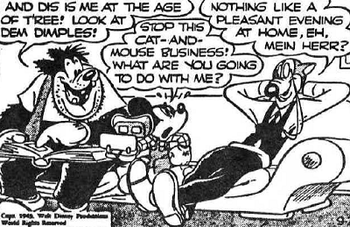
A spy for Nazi Germany and partner-in-crime of Pete. He's also known as Agent 17.
- Brains and Brawn: He is the brains, Pete provides the brawn.
- High-Class Glass: He only wears it in private and when he does, it's on his left eye.
- The Mole: He and Pete work for the American army in order to have first seat tickets to all secret projects. They also regularly purchase war bonds, to Mickey's disgust, because doing so makes for a good cover and a wise investment because the money will go into developing the very secrets they aim to steal.
- Nazi Nobleman: He's never said to be a nobleman and there's no telling whether his "pastry shop in Vienna" is a full lie or a convenient truth to hide behind (he does know how to make fruit preserves), but he's got the monocle, the "Von"-name, and is identified as a "personal buddy of Hitler's".
- The One Thing I Don't Hate About You: A running gag in "On a Secret Mission" is that the Nazis love American culture. Von Weasel has a weakness for cowboy movies.
- Put on a Bus: The 90s kickstarted the return of Pete's other 30s/40s partners-in-crime, Sylvester Shyster and Eli Squinch. It's no surprise Von Weasel hasn't been brought back and isn't likely to anytime soon. A rewrite'd be mandatory.
- The Von Trope Family: "Von Weasel".
- Wicked Weasel: He's a weasel and deceitful.
- You Have Failed Me: Played straight and averted. After failing to acquire (photos of) America's new long-range combat plane known as "The Bat", Pete notes to Von Weasel: "Frankly, I'm a little noivous, boss! I know what you did to de others who woiked for you... and failed...". Notwithstanding this history, Von Weasel tells him not to be afraid and never actually gives any indication Pete is to be offed too.
Doc Wombat

A country fellow and smuggler, as well as a friend of Pete.
- Informed Species: He does not not look a wombat, but he'd be mistaken for a regular dogface were it not for the name.
- "Scooby-Doo" Hoax: To keep people from snooping, Doc Wombat and Pete had set up a ghost story for Specterville, which is a ghost town deserted in 1879 when the last gold was found. The ghosts of the town would not take kindly to strangers, though leave alone Doc because he lives there and Pete because he's a regular visitor of Doc's. Any plane that'd try to land would be pulled down by spectral forced (in reality a controlled magnet), while any strangers staying would be visited by the ghosts (in reality a hologram). To cover for the smuggler plane specifically, a story about a ghost plane was thought up that sometimes was the smuggler plane and sometimes a hologram.
Scuttle

Principally partner-in-crime of Pete and Dum-Dum, but can occasionally be found working with other villains. He's almost always found in a subordinate role and is usually happy this way.
- Brains and Brawn: With Dum-Dum, it depends on the story who is the brains. Sometimes it's Scuttle, but other times Dum-Dum takes on the role of leader. Scuttle never qualifies as the brawn, but Dum-Dum occasionally does. In fact, this was the setup in their earliest stories like "Alaskan Adventure" and "Backwoods Bugaboo".
- Composite Character: Overlaps with Ascended Extra, Decomposite Character, Suspiciously Similar Substitute, and Sudden Name Change with a dash of I Have Many Names. Scuttle as he's known today is an invention of the 80s, but goes back several more decades. He has his origins in the Fallberg-Murry stories and those two believed in making standalone stories rather than creating continuity. As well, Murry limited himself to dogfaces when designing new characters and developed a few go-to models (with minor variations) easy for him to draw because of familiarity. The character today known as Scuttle was one of these go-to models. Although the model was regularly partnered with Pete and/or Dum-Dum, it could show up working with anyone, including itself like when it was doubled for use as the Terwilliger Twins in "The Secret of the Swamp", and didn't even have to take the role of a criminal, like when it was assigned the role of Dr. Quantum in "The Marvelous Magnet". Furthermore, the consistency of being Pete's and/or Dum-Dum's partner-in-crime is not a guarantee to same-characterness either, because the name given to the model never was the same between any two stories and Mickey never recognized him unlike he did Pete, sometimes explicitly. And even if one were to retroactively interpret this use of the model all Scuttle, then ambiguity emerges from the occasional model variation, like the fat version (Bushface) that shows up in "The Big Christmas Tree Mystery", the beardless version (Frenchy) of "The Return of the Phantom Blot", or the other beardless version (Slink) in "The Tortoise Shell Treasure". Some of Scuttle's better known names, on account of them appearing in high profile stories, are Ropey ("Captures the Range Rustlers"), Catfoot ("The Legend of Loon Lake"), Saltspray (title?), Slowdraw ("Mickey's Strange Mission"), and Yardarm (title?). "Yardarm" also has the honor of being the name he got when he appeared in the DuckTales (1987) episode "The Pearl of Wisdom". Other names the model has appeared under are Sourdough Sam/Skulk ("Alaskan Adventure"), Barney ("Backwoods Bugaboo"), Pickhandle ("The Mystery of Misery Mesa"), Snark ("Arctic Roundup"), Squinch ("The Treasure of El Dorado"), Lynx-Eye ("Undercover Mountie"), Chum ("Strange Cargo to Pingoola"), Smite ("The Whale Chasers"), Deadeye ("Lair of the Zoomby"), Slick ("Moose Call"), Dr. Gantry ("Desert Dilemma"), and Mulligan ("Rainbow Runaround"). The only Western Publishing era story to call him "Scuttle" is "The Missing Merchantman", but it's the name that's been settled on after the 70s and the one used for fresh translations.
- Fat and Skinny: Scuttle is the skinny one, while the role of fat one is filled by either Pete or Dum-Dum.
- Rogues' Gallery Transplant: He debuted as an enemy of Donald Duck during one of the times Pete appeared in a Disney Ducks story.
Dum-Dum
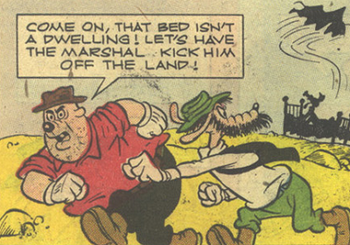
A criminal who is often the partner-in-crime of Scuttle, sometimes serving as his henchman, sometimes essentially taking the role of Pete. At times, the two work for Pete (or another employer), though unlike Scuttle Dum-Dum never is Pete's sole henchman.
- Brains and Brawn: It depends on the story who is the brains. Sometimes it's Scuttle, but other times Dum-Dum takes on the role of leader. Scuttle never qualifies as the brawn, but Dum-Dum occasionally does. In fact, this was the setup in their earliest stories like "Alaskan Adventure" and "Backwoods Bugaboo".
- Composite Character: Overlaps with Ascended Extra, Decomposite Character, Suspiciously Similar Substitute, and Sudden Name Change with a dash of I Have Many Names. Dum-Dum as he's known today is an invention of the 80s, but goes back several more decades. He has his origins in the Fallberg-Murry stories and those two believed in making standalone stories rather than creating continuity. As well, Murry limited himself to dogfaces when designing new characters and developed a few go-to models (with minor variations) easy for him to draw because of familiarity. The character today known as Dum-Dum was one of these go-to models. The model is less distinct than Scuttle's and only recognized when partnered with Scuttle and/or Pete. Furthermore, this context is not a guarantee to same-characterness either, because the name given to the model never was the same between any two stories and Mickey never recognized him unlike he did Pete, sometimes explicitly. And even if one were to retroactively make this use of the model all Dum-Dum, then ambiguity emerges from that occasional model variation, like the long-eared version (nameless) that shows up in "Donald Duck Captures the Range Rustlers" or the large-chinned version (Bullneck) of "Backwoods Bugaboo". Other names the model has appeared under are Gumboot/Tiny ("Alaskan Adventure"), Lunk ("The Mystery of Misery Mesa"), Filch ("The Incredible Box Top Plot"), Flabb ("The Treasure of El Dorado"), Cokey ("Twenty Fathoms to Treasure"), Moose ("Undercover Mountie"), Harry ("Strange Cargo to Pingoola"), Spike ("The Whale Chasers"), Ketch ("Trapped on Wreckers Reef"), Galvin ("Desert Dilemma"), Willie ("Rainbow Runaround"), and Mack ("The Dream House"). The only Western Publishing era story to call him "Dum-Dum" is "Moose Call", but it's the name that's been settled on after the 70s and the one used for fresh translations.
- Fat and Skinny: Dum-Dum is the fat one, Scuttle is the skinny one.
- Large and in Charge: Sometimes when working with Scuttle, like in "The Whale Chasers".
- Perma-Stubble: In most of his appearances Dum-Dum's got this. Rarely he has a full beard and sometimes he's clean-shaven, but the stubble is his most recurring look.
- Out of Focus: Dum-Dum has only been featured in a handful of comics after the 70s.
- Rogues' Gallery Transplant: He debuted as an enemy of Donald Duck during one of the times Pete appeared in a Disney Ducks story.
El Cad
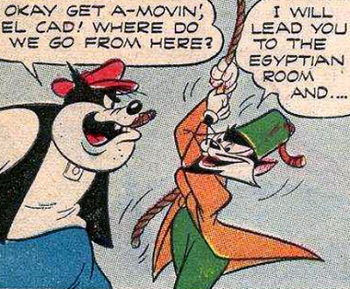
A museum thief with an eye for commercializing antiquities.
- Beard of Evil: El Cad's goatee looks like it'd be sharp enough to stab someone with. In fact, along with Fangs Are Evil, El Cad's design includes a lot of sharp angles as a contrast to Pete's round shapes.
- Brains and Brawn: He'd work alone if not for the occasional need of some brute force, which Pete can provide.
- Cats Are Mean: El Cad's Punny Name combines "cat" and "cad", which should tell you enough about his attitude.
- Fat and Skinny: He's skinny, Pete's fat.
Al Popone
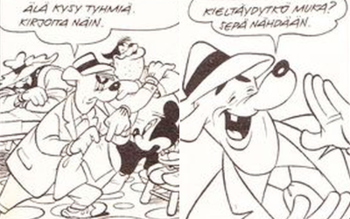
One of Pete's henchmen.
Monkey scientist

A scientist (whose name is not given) that teamed up with Pete to create diamonds from coal.
- Brains and Brawn: He is the brains, Pete provides the brawn.
- Labcoat of Science and Medicine: He's working with coal and heavy machinery. He does not need a labcoat, but a good overall and a helmet.
- No Name Given: Not even a nickname or anything!
- Polluted Wasteland: He and Pete used Lost Green Valley as the dumping grounds of all the waste produced in the diamond making process. That way, they wouldn't draw attention with a smoke stack as the only one to know of anything going on was a simple farmer living in the valley.
- The Stoic: He is proud of his work, but underreacts to anything that's not his department.Scientist: "No harm done, but the lady is getting a bit tiresome!"
Joe Wharfrat
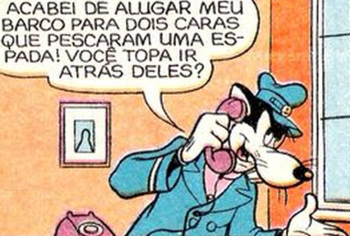
A sailor who sometimes teams up with Pete.
- Fat and Skinny: He's skinny, Pete's fat.
- You Dirty Rat!: All the more noticeable when the heroic protagonist is a mouse.
Weasel
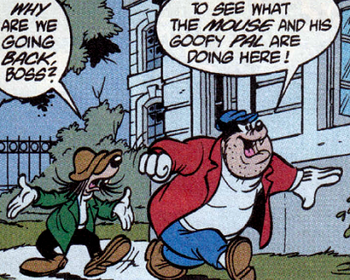
One of Pete's henchmen.
- Composite Character: Overlaps with Remember the New Guy?, Suspiciously Similar Substitute, and Sudden Name Change. Weasel is a creation by Bob Langhans and comes in two variants: average height and short. The former, among others, shows up in "Gentleman Pete" and "The Big Escape", and the latter in "The Lost Palace of Kashi", "The Steamboat Trip", and "The Box Office Heist". Only "Gentleman Pete" and "The Lost Palace of Kashi" have had releases in English, and in the former the character is known as Henchy. For unknown reasons, a year after "The Lost Palace of Kashi" Langhans stopped using Weasel and joined in on portraying Scuttle as Pete's main partner-in-crime.
- Made a Slave: Sort of as part of the "Everybody Laughs" Ending in "The Lost Palace of Kashi", coincidentally and unfortunately his final appearance. After Pete's and Weasel's maltreatment of two nomads and an attempt to steal various ancient artifacts, the nomads want them executed. Pete begs Mickey to help him, which Mickey agrees to if they first fix up the plane they flew into some trees during their failed escape. Once they've done so,
 Mickey points out to the chief the two crooks are much more useful alive than dead and the two are dragged off for more work.
Mickey points out to the chief the two crooks are much more useful alive than dead and the two are dragged off for more work. - One-Steve Limit: Averted. There are two other crooks named Weasel, one of which shows up in "The Crooked Clown Case" and the other in "The Coconut Caper".
Dexter Dingus

A brilliant inventor whose criminal career is only hampered by his physical shortcomings and lack of a spine. To compensate, he has teamed up with Pete. The two can't stand each other, which tends to be the reason their plans fail.
- Brains and Brawn: Dexter is the brains, Pete the brawn.
- The Dog Bites Back: Dexter being the dog in this case. Happened in "The Great Birthday Robbery" and "The Copy-Cat Crimes".
- Invisibility Cloak: Dexter made two, designing them so that the wearers even became intangible but could still pick up things if brought within their sphere of influence. Pete earned the nickname "The Fog" while pulling heists with it. Only danger it could pose was if the two wearers would ever pass each other in intangible form, which Mickey tried to stop Pete.
- In-Series Nickname: Pete, The Nicknamer, calls him Dexie. Dexter hates that.
- Shorter Means Smarter: Dexter's a shorty and not only smarter than Pete in terms of inventing but also in performing their schemes with minimal risk. Too bad all the authority between them is held by Pete's fists.
- Mad Scientist: He's actually not all that mad, but he's still cooking up fancy inventions for the sake of personal gain regardless of how it effects others. There's also something to be said for his choice to keep teaming up with Pete.
- Stay in the Kitchen: Oddly invoked despite Dexter being a guy. Pete is very resentful towards him for being afraid to stand up to him.
Jack the Jerk
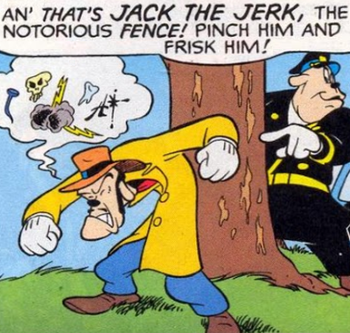
One of Pete's fences.
- No Honor Among Thieves: When Jack thinks Pete by accident picked a meeting spot crawling with cops and is spotted, he immediately rats out Pete as the one he has business with in a Taking You with Me deal.
- Run for the Border: The reason Jack insists on a meeting at 17:00 is because he wants to skip town at 18:00 what with the cops closing in on him.
"Muck" Raker

An Old Friend of Sylvester Shyster and just as much of a rat. He's the owner of the Daily Quack, a newspaper.
- Big, Thin, Short Trio: Forms this with Sylvester and Pete.
- Da Editor: A corrupt one.
- False Reassurance: Mickey should've paid attention to the small matter that "Politicians sometimes play dirty tricks! Is that the whole story? Don't worry! We'll do the right thing with that photo!" does not contain any promise to not print it. Much like Sylvester knows how to spin the law, Muck knows how to spin words.
- Nerd Glasses: Overly large ones.
- No Name Given: Forename, that is. The one time his name is mentioned, it's written as if "Muck" is a nickname. On his office door "M. Raker" is written, so his first name does start with a "M".
- Old Friend: To Sylvester Shyster.
- Propaganda Machine: Raker and Pete do everything in their power to make Mickey look bad and improve the chances of Shyster getting elected mayor.
The Phantom Blot's allies
Mr. X

A mad scientist who regularly teams up with the Phantom Blot. He only appeared in one American story but was picked up for a few more by Brazil.
- Atrocious Alias: Most people consider Mr. X an intimidating enough name, but not Donald: "What kind of guy would sign his name with an "X"? Heh heh!"
- Big Bad Duumvirate: Whenever he teams up with the Phantom Blot.
- Einstein Hair: It points in all possible directions.
- Even Evil Has Loved Ones: The Phantom Blot is his friend. His only one. In his first story, Mickey and Goofy trick Mr. X into hammer-KO'ing the Phantom Blot by making him think he's dealing with a spy in disguise. Once Mr. X realizes what he's done, he freezes in shock and horror before regaining his bearings to escape.
- Kansas City Shuffle: Mickey threw one up for him. Mr. X had sent letters ahead announcing his plans to rob Scrooge McDuck's Money Bin and to free the Phantom Blot so he could join him in this historic crime. Cognizant that Mr. X would have a fool-proof plan, Mickey had Goofy pretend to be the Phantom Blot, claiming to have escaped on his own as could be expected from a master criminal, so that the real Phantom Blot would stay in jail and Goofy would be able to get close to Mr. X to thwart the robbery.
- Labcoat of Science and Medicine: Always wears his no matter what he's doing.
- Let X Be the Unknown: "The Mysterious Mr. X".
- Mad Scientist: Brazil prefers to call him Dr. X.
- Mind-Control Device: The ray-o-copter in "The Phantom Blot Meets the Mysterious Mr. X".
- No Name Given: He's only ever referred to as Mr. X.
The Phantom Brat
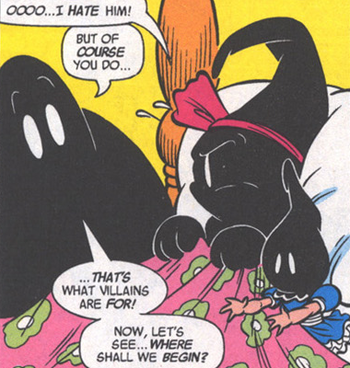
The Phantom Brat is the young daughter of the Phantom Blot. She's not a danger to anyone, but has acquired a villain perspective from her father. With him in jail, she's being raised by their housekeeper, Mrs. Fragmuffin.
- Creepy Child: That she goes around in an outfit like her dad's is one thing, but all those hooded dolls and plushies are a bit much.
- Cut Short: The Phantom Brat was the biggest deal cast addition made by the Mickey Mouse Adventures series, with the editorial asking for feedback on her. She was received well, but no stories featuring her followed due to the series dying in the Disney Implosion ten issues later. No other writer has picked her up either.
- Daddy's Girl: She's a fan of her father and expects a bedtime story about his adventures every night.
- Even Evil Has Loved Ones: After watching her father plummet to his quite possible death:Phantom Brat: "Daddy...*sob!* I didn't want the diamond that badly..."
- Face of an Angel, Mind of a Demon: Possibly. The editorial in Mickey Mouse Adventures #8 reads: "We know that no jail can hold the Blot for long, so his future as an unpredictable opponent is clear, but what about his daughter? Is she a sweet tyke who just happens to have a felon for a father? Or is she as twisty as dear old dad?"
- No Name Given: The name "Phantom Brat" was used solely in the editorial of Mickey Mouse Adventures #8 and placed between quotation marks to boot.
Alberta
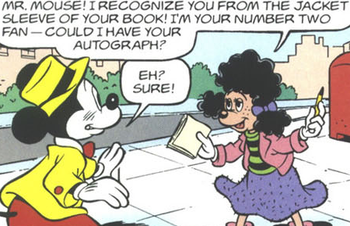
A little girl of criminal disposition who works for the Phantom Blot.
- The Artful Dodger: Her clothes and employ with the Phantom Blot mark her as such. The whereabouts of her parents aren't known.
- Face of an Angel, Mind of a Demon: Her design works with both aspects. Her hair's black and curly, which is as much coding for her youthfulness as for her deviousness. The same goes for her Youthful Freckles.
- Little Miss Con Artist: She's as innocent-looking as a ±9 year old girl can be and delights in the way it allows her to trick people. She knows her appearance goes a long way to making her actions seem harmless, easily long enough to spring a trap.
